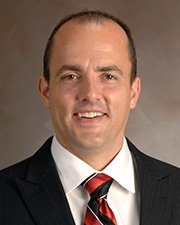Sports Medicine Broadcast

Turf Injuries in Competitive Athletes
Turf Toe is ever-changing. Dr. Paul Shupe and Joseph Eberhardt discuss some of the facts and history of turf toe at the Memorial Hermann sports medicine update.

What can I do to benefit my athlete since turf is here to stay?
Making sure the field is well maintained, and proper personal protective equipment is significantly important. A lot of football players like to wear narrow cleats which can contribute to lower extremity injuries based on the cleat pattern, length, and width of the shoe. The time of day we practice is important as well.
Is there any data or research done about laces and appropriately tying the shoe with appropriate arch support?
Great question, I’d have to look into that. I’m sure there are studies – I didn’t delve into that. These are very important questions, I think that core strengthening is a very pertinent point as well.
You spoke about an increase in PCL injuries. From my education, the mechanism of injury for PCL is that dashboard injury, coming from direct force on the anterior tibia. Is there any research, or from your background and knowledge, why is it that we’re seeing more prominence from that mechanism on that turf?
When it’s not a dashboard injury, the common mechanism is that you onto your knee bent at 90 degrees, your toe has interacted and your cleat is stuck in the turf so it’s not giving away.
Your foot is in this dorsiflexed position and you land on that knee with all of the force going back through, as opposed to if the shoe gives out allowing you to land on less of a 90-degree angle.
Is there any correlation to gastrocnemius weakness regarding those Turf Toe injuries?
I think that’s a valid argument, I don’t have enough science or background to say but I do think that would be an interesting thing to study.
We talked about the history of turf in your presentation, would you say we’ve moved in a safer direction? Are we moving to a safer surface?
I think we are, I think we’re moving to a safer surface for our lower-level athletes. I think our higher-level athletes have different muscle builds and different muscle types that may lead to some of those injury at a higher level.
I do think the technology that’s going into it is moving towards a safer playing surface, I don’t think there’s much we can do about the heat and some of the other things, and they are looking into that. I think we are moving there, the important thing here is that turf isn’t going away, I don’t think that we’ll ever go back to grass.
With technology moving forward, I do think it’s becoming safer. I don’t think it’ll ever be 100% safe but with education, and proper maintenance, I think we can make it as safe as we can.
You mentioned the coconut or the cork, those things are natural materials that would rot, and putting turf in is a lengthy and expensive process. How does it make sense for a high school field to put something that might rot underneath there?
So part of it is just the turnover of it, so it’s got to be properly maintained. So when we use the proper equipment and the proper rakes just to shift it around that’s a valid question, especially in a wet and humid environment like it is here. It’s not being used a ton yet, and I think that’s yet to come. We may determine years from now that it’s a bad idea.
Rice uses wood instead of rubber on their field, I found that interesting when we played there last year.
Did you notice any difference?
Thinking back, I think your point about feet being sore on these fields; is a major problem. Your feet hurt at the end of the day on the rubber. There’s less of that impact.
We did have in our Rice game, but I don’t think it makes a difference in injury, we had an ankle fracture that game, we had a significant hamstring rupture, and a couple of other things so I don’t think it makes a difference as far as the interaction of the cleat but it may make it as far as the softness.
You mentioned your time in the military where you would sweep and make sure there was no foreign debris as part of the turfing. Can you speak briefly about your time serving our country?
I served in the Navy for 12 years and loved it. I trained as an intern, and then I was 3 years as a flight surgeon with the Marines, serving in an F-18 squadron. I had the opportunity to go all over the world with that, then finished my ortho training in San Diego.
Then I spent 4 years as an orthopedic surgeon in Japan and Florida, and loved it.
They were not allowing me to do sports medicine, which is what I came to Houston to do a fellowship for. So, there are nothing but good things to say about the Navy and those who serve.
People who go to the military to become physical therapists or surgeons, can you talk about what they should and shouldn’t think about before?
So for me, it was an avenue for me to pay for medical school. They paid for me to go to George Washington University, and so one thing is well paid and very well educated no matter where I go in the world or in the country.
The training that we got is respected. Same thing for physical therapy. Other than the Naval Academy, and probably West Point Force Academy, there are not a lot of athletic trainers in the military.
But you certainly get that experience working with different types of teams, and I think the opportunities that you get serving far outweigh the downsides of deployment or other unfriendly things like being told where you have to be, when you have to be there, where to have to move to, overall very positive.
I think the Navy and all of the armed forces provide great education both in-person and online learning. A lot of the coremen would enlist, and have their education paid for while working on campus, and several of the individuals I worked with would graduate with a year’s degree while they were on active duty service with no cost to them.
Got Questions about Turf Toe?
Dr. Paul Shupe – Reach out to his office and tell them the Sports Medicine Broadcast sent you
Contact Us:
Shawn Ready – shawnreadyatc@gmail.com
Dr. Mark Knoblauch – maknobla@Central.UH.EDU
Dr. Layci Harrison – lharris5@Central.UH.EDU
Bob Marley – Bob.Marley@uth.tmc.edu
ATCornerPodcast – ATCornerds@gmail.com
Joseph Eberhardt – eberhardtj@pearlandisd.org
Christina Fry – fryc@pearlandisd.org
These people LOVE Athletic Trainers and help support the podcast:
Frio Hydration – Superior Hydration products.
Donate and get some swag (like Patreon but for the school)
HOIST – No matter your reason for dehydration DRINK HOIST
MedBridge Education – Use “TheSMB” to save some, be entered in a drawing for a second year free, and support the podcast.
Marc Pro – Use “THESMB” to recover better.







 Visit Podcast Website
Visit Podcast Website RSS Podcast Feed
RSS Podcast Feed Subscribe
Subscribe
 Add to MyCast
Add to MyCast